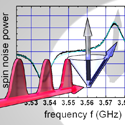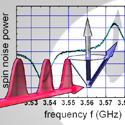Noisy spins
Though they are often disruptive, statistically ever-present fluctuations can at times provide valuable information about the dynamics of a physical system. For example, a multitude of independently precessing spins in a semiconducting material gives rise to spin fluctuations that can be probed via spin noise spectroscopy. This method, previously used for gaseous atoms, was introduced to study semiconductors in 2005, where it offers the dual benefits of low heating and smaller perturbative effects on the probed spin dynamics. These advantages, however, were to some extent outweighed by the inability of spin noise spectroscopy to probe higher frequencies.
In a Rapid Communication published in Physical Review B, Georg M. Müller, Michael Römer, Jens Hübner, and Michael Oestreich from Leibniz Universität Hannover, Germany, use a pulsed Ti: Sapphire laser (instead of a continuous-wave laser) to effectively slow down spin fluctuations as though they were viewed under a strobe light, and perform spin noise spectroscopy at ultrahigh frequencies up to several . This extension to higher frequencies, without any loss of sensitivity, may reshape spin noise spectroscopy into a tool that studies intriguing phenomena such as Bose-Einstein condensation of magnons and reaction kinetics in chemical physics. More immediately, this development enables the authors to explore in detail the spin dynamics in -doped —in many respects the quintessential spintronics material. – Sami Mitra





